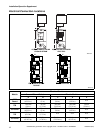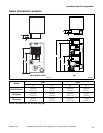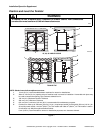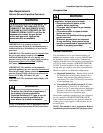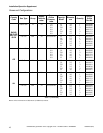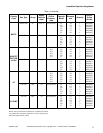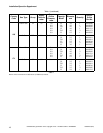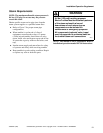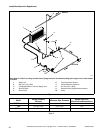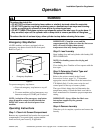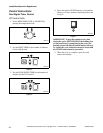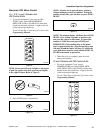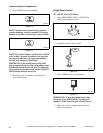
© Published by permission of the copyright owner – DO NOT COPY or TRANSMIT
Installation/Operation Supplement
19
70392201 (EN)
Exhaust Requirements
Make-Up Air
IMPORTANT: Do not obstruct the flow of
combustion and ventilation air.
A tumbler is forced air exhausted and requires
provisions for make-up air to replace the air exhausted
by the tumbler.
The required make-up air opening to the outside for
each
tumbler is:
709 sq. cm (110 sq. in.) for 25 and 30 pound models
928 sq. cm (144 sq. in.) for 35 and 55 pound models
1418 sq. cm (220 sq. in.) for T30 models
1856 sq. cm (288 sq. in.) for T45 models
Make-up air openings with louvers will restrict
airflow. The opening must be increased to compensate
for area taken up by louvers.
If it is necessary to duct make-up air to the tumbler(s),
increase the area of the ductwork by 25% to
compensate for any restriction in air movement.
Venting
Proper sized exhaust ducts are essential for proper
operation. All elbows should be sweep type. Exhaust
ducts must be assembled so the interior surfaces are
smooth to prevent the accumulation of lint.
DO NOT use plastic or thin foil flexible ducts. Use
exhaust ducts made of sheet metal or other
noncombustible material. Use duct tape or pop-rivets
on all seams and joints.
Verify that old ducts are thoroughly cleaned out before
installing new tumbler.
NOTE: The ducts must be equivalent in strength
and corrosion resistance to ducts made of
galvanized sheet steel not less than 0.495 mm
(0.0195 inches) thick.
IMPORTANT: For best performance, provide an
individual exhaust duct for each tumbler. Do not
install a hot water heater in room containing
tumblers. It is better to have the water heater in a
separate room with a separate air inlet.
NOTE: This manual is only a supplement. Refer to
installation/operation manual for full instructions.
A drying tumbler produces combustible
lint. To reduce the risk of fire, the tumbler
must be exhausted to the outdoors.
W057
To reduce the risk of fire and accumulation
of combustible gases, DO NOT exhaust
tumbler air into a window well, gas vent,
chimney or enclosed, unventilated area
such as an attic wall, ceiling, crawl space
under a building, or concealed space of a
building.
W059
WARNING




